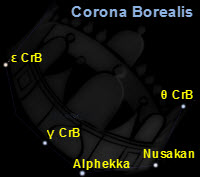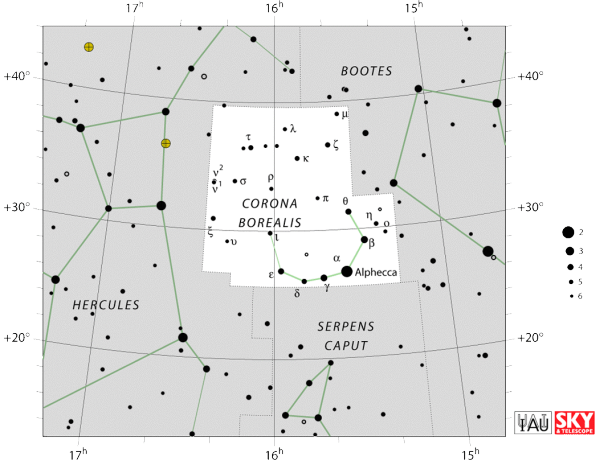 In mythology Corona Borealis is said to represent the crown of Dionysus tossed into the heavens to prove his love for Ariadne, daughter of King Minos of Crete. She had played an instrumental role in helping Theseus slay the Minotaur, a creature with the head of a bull on a human body. Ariadne’s mother, Pasiphae had given birth to the creature after copulating with a bull owned by King Minos. In order to cover up the shame, the Minotaur was imprisoned in a labyrinth so complex, neither the Minotaur nor anyone else who ventured in could ever find their way out.
In mythology Corona Borealis is said to represent the crown of Dionysus tossed into the heavens to prove his love for Ariadne, daughter of King Minos of Crete. She had played an instrumental role in helping Theseus slay the Minotaur, a creature with the head of a bull on a human body. Ariadne’s mother, Pasiphae had given birth to the creature after copulating with a bull owned by King Minos. In order to cover up the shame, the Minotaur was imprisoned in a labyrinth so complex, neither the Minotaur nor anyone else who ventured in could ever find their way out.
When Theseus, son of King Aegeus of Athens, came to Crete, Ariadne fell in love with him instantly, telling him of the existence of the Minotaur. Theseus offered to kill the creature, and after consulting Daedalus; designer of the underground maze, she gave him a ball of thread to use in finding his way.

Theseus tied one end to the door of the labyrinth and payed out the thread as he went along, eventually locating the Minotaur and slaying the beast. Re-emerging Theseus duly married Ariadne, sailing off with her, but on reaching the island of Naxos, he deserted her. Inconsolable, there she sat cursing Theseus for his ingratitude, vowing never to marry a mortal again. Thus the god Dionysus came upon her, and taking pity on Ariadne married her, tossing his crown into the heavens to prove he was a god, its jewels turning into stars.
The Constellation
 A semi-circle of stars between Boötes and Hercules marks the golden crown worn by Princess Ariadne of Crete when she married the god Dionysus. The crown is said to have been made by Hephaestus, the god of fire, and was studded with jewels from India
A semi-circle of stars between Boötes and Hercules marks the golden crown worn by Princess Ariadne of Crete when she married the god Dionysus. The crown is said to have been made by Hephaestus, the god of fire, and was studded with jewels from India
The constellation of Corona Borealis itself is small but recognizable, with only four stars brighter than magnitude 3.00. It was first catalogued by the Greek astronomer Ptolemy in the 2nd century. Its brightest star is officially called Alphecca from the Arabic name for the constellation, although it is also known as Gemma, the Latin for ‘jewel’.
Alpha Coronae Borealis is the brightest of the seven stars that make up Ariadne’s crown. It is an eclipsing binary star classified as an EA variable, with a period of 17.36 days. The star has an apparent magnitude that varies between 2.21 and 2.32. It is approximately 75 light years distant.
The second brightest star in Corona Borealis, Beta Coronae Borealis is 114 light years distant; Its traditional name is Nusakan. It is a spectroscopic binary, with a period of 10.5 years as well as being a variable star with a period of 18.5 days, varying between 3.65 and 3.72 magnitudes. Alpha-2 Canum Venaticorum variables are main sequence stars of spectral class B8 to A7 that are chemically peculiar and have strong magnetic fields and strong strontium, silicon or chromium spectral lines. They are named after a star in the Cor Caroli system in the nearby constellation Canes Venatici.
T Coronae Borealis is a recurrent nova, sometimes also known as the Blaze Star. It is a spectroscopic binary with a period of 227.6 days. The star usually has a magnitude of about 10-10.8, but in May 1866 it reached magnitude 2 and magnitude 3.0 on February 9, 1946. T Coronae Borealis is a red giant. It belongs to the spectral type M3III and is approximately 2,000 light years distant. Rho Coronae Borealis is a yellow dwarf star with an apparent magnitude of 5.4. It belongs to the spectral class G0-2 and is considered a solar twin, with almost the same mass, luminosity and radius as the Sun. In 1997, a planet was discovered in the star’s orbit. It lies 56.2 light years distant.
R Coronae Borealis is a yellow supergiant star, belonging to the spectral class F7, with an apparent magnitude of 6.46. It is about 6,000 light years distant. It is a variable star, with its brightness fading by several magnitudes at irregular intervals.R Coronae Borealis serves as a prototype of a class of stars known as the RCB variables. The star’s variability is the result of a cloud of carbon dust created in the line of sight that dims the star’s apparent visual magnitude by several magnitudes. the apparent magnitude ranges from 5.71 to 14.8. Due to the dramatic changes of brightness, R Coronae Borealis is also known as the Fade-Out Star or Reverse Nova.
Kappa Coronae Borealis is an orange subgiant belonging to the spectral class K1 approximately 101.5 light years from Earth. It has an apparent visual magnitude of 4.82. A giant planet was discovered in the star’s orbit in 2007.
There are no readily observed deep sky objects in Corona, but the galaxy cluster Abell 2065; a densely populated cluster some 1 and 1.5 billion light years distant, lies about a degree southwest of the star Beta Coronae Borealis, in the southwest corner of the constellation.
The cluster contains more than 400 galaxies in an area spanning about one degree in the sky and has an apparent visual magnitude of 16.5.

- Log in to post comments
